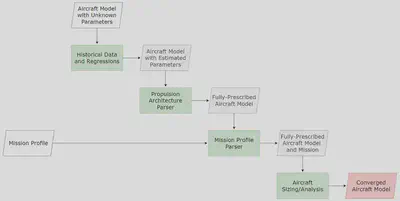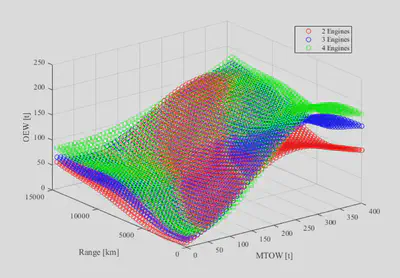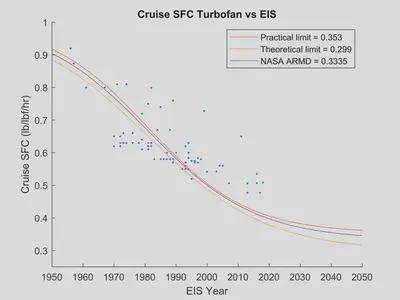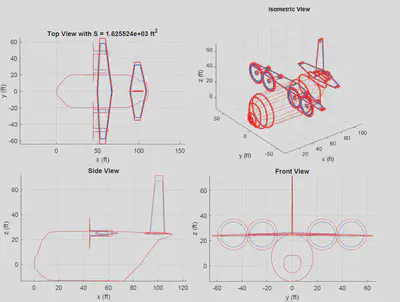Future Aircraft Sizing Tool (FAST)
An open-source, MATLAB-based aircraft sizing tool for designing and analyzing conventional and electrified aircraft concepts with any propulsion architecture.

Overview
The Future Aircraft Sizing Tool (FAST) is an innovative, open-source, MATLAB-based software developed by the IDEAS Lab at the University of Michigan as part of a research project funded by NASA’s Aeronautics Research Mission Directorate and the Electrified Powertrain Flight Demonstration (EPFD) project. FAST enables the design and analysis of both conventional and electrified aircraft concepts across any propulsion architecture. By integrating parametric physics-based and data-driven models, it accommodates a variable level of input detail, making it accessible for users with minimal prior knowledge while offering the granularity required for higher-fidelity analysis.

Disclaimer: The figures on this page are part of a series of manuscripts in progress and should not be used without permission. Please cite them using the citation provided under each figure.
Key Features:
- Aircraft Conceptual Design Tool: FAST is designed for rapid exploration of the design space at the early stages of aircraft development. It supports the evaluation of thousands of configurations, offering rapid calculations essential for early-stage analysis.
- Flexible Input Requirements with Scalable Fidelity: FAST adapts to the user’s level of detail and expertise. At its most basic level, users can begin designing a new concept by providing minimal inputs such as range, payload, vehicle class, and propulsion system type. For more advanced and higher-fidelity analysis, users can specify additional parameters to increase the design’s granularity. This flexibility, enabled by integrated parametric physics-based and data-driven models, allows FAST to support both rapid exploration and detailed design analysis.
- Embedded Historical Database with Predictive Modeling: FAST uses a historical database of over 200 aircraft and engines, compiled from type certificate data sheets (TCDS) provided by governing bodies like the FAA and EASA, and supplemented by existing databases. This open-source, collaborative database is continuously updated. FAST employs Gaussian Process Regressions (GPRs) to predict unknown aircraft parameters from fundamental requirements such as range and payload weight, as well as designer-specified constraints like thrust-to-weight ratio and wing loading. This allows FAST to function with minimal input by estimating missing variables required for sizing analysis and making future projections on key performance parameters. The aircraft database and the regressions are also available as stand-alone packages–see regressions.

Operating Empty Weight (OEW) Regression Response Surfaces created in FAST. Source: Arnson, M., Aljaber, R., & Cinar, G. (2025). Predicting Aircraft Design Parameters using Gaussian Process Regressions on Historical Data. AIAA SciTech Forum 2025. Accepted, in press. - Versatile Design Capabilities: FAST supports a wide range of aircraft concepts, from conventional designs to advanced electrified aircraft. It can size and design both fully electric and hybrid electric aircraft, powered by batteries and/or hydrogen fuel cells.
- Propulsion Architecture Flexibility: FAST can represent and size any propulsion architecture and unconventional energy sources, providing unparalleled flexibility in design and analysis. This facilitates the exploration and development of next-generation electrified aircraft.
- Embedded Physics-based and Data-driven Models: FAST uses a combination of physics-based and data-driven models for increased accuracy beyond conventional methods.
- Future Technology and Key Performance Parameter Projection: FAST leverages historical data, regressions, and physical drivers to predict future trends in aircraft design. This capability enables FAST to size and analyze aircraft concepts up to the year 2050, projecting key performance parameter values into the future. These insights can support further studies on cost and emission reduction strategies.

Cruise Specific Fuel Consumption (SFC) projection based on historical data and technology limits. Note: This figure is part of a manuscript currently under review with the Journal of Aircraft. If referencing this figure, please cite it as: Acar, H., Arnson, M., Tsai, M., & Cinar, G., ‘‘Historical Trends and Future Projections of Key Performance Parameters in Aircraft Design’’, under review, Journal of Aircraft, 2024. - Detailed Mission Performance Analysis: FAST offers full mission history, time step by time step, for flight mission performance evaluation. This allows for both design and off-design analyses.

FAST output: A subset of figures summarizing the flight mission history. Source: Mokotoff, P., Arnson, M., & Cinar, G. (2025). FAST: A Future Aircraft Sizing Tool for Electrified Aircraft Design. AIAA SciTech Forum 2025. Accepted, in press. - Integrated Visualization Feature: FAST provides visualizations of the aircraft geometry’s outer mold line and schematic representations of its propulsion architecture. Users can create custom geometries or utilize preset configurations available in FAST. The tool dynamically updates to reflect changes in the aircraft’s shape and size as the design process converges, allowing users to see how the aircraft’s dimensions change from its initial condition.

FAST output: Scaling a notional LM-100J concept by changing the design requirements. Initial geometry in blue, sized geometry in red. Source: Khailany, N., Mokotoff, P., & Cinar, G. (2025). Aircraft Geometry and Propulsion Architecture Visualization for the Future Aircraft Sizing Tool (FAST). Accepted, in press.
Get Started with FAST
FAST is open-source and freely available under an Apache 2.0 license. To start using FAST, visit the GitHub repository here. The repository contains detailed documentation, including a comprehensive user guide to help you get started with the software.
If you use FAST in your research or projects, please cite our work as follows (note that these are provisional citations, awaiting final release in 2025):
- Aircraft Sizing: Mokotoff, P., Arnson, M., & Cinar, G., “FAST: A Future Aircraft Sizing Tool for Electrified Aircraft Design,” in press, AIAA SciTech Forum, 2025.
- Regressions: Arnson, M. and Aljaber, R. and Cinar, G., “Predicting Conceptual Aircraft Design Parameters Using Gaussian Process Regressions on Historical Data,” in press, AIAA SciTech Forum, 2025.
- Visualization: Khailany, N., Mokotoff, P., & Cinar, G., “Aircraft Geometry and Propulsion Architecture Visualization for the Future Aircraft Sizing Tool (FAST)”, in press, AIAA SciTech Forum, 2025.
- Historical Trends: Acar, H., Arnson, M., Tsai, M., & Cinar, G., ‘‘Historical Trends and Future Projections of Key Performance Parameters in Aircraft Design’’, under review, Journal of Aircraft, 2024.
FAST Video Tutorials Explore our comprehensive video tutorials to get the most out of the Future Aircraft Sizing Tool (FAST). Hosted by the IDEAS Lab researchers, these tutorials cover everything from installation to advanced features. Visit our YouTube channel for all videos.
Stay tuned for more tutorials and updates.
FAST Video Tutorials Explore our comprehensive video tutorials to get the most out of the Future Aircraft Sizing Tool (FAST). Hosted by the IDEAS Lab researchers, these tutorials cover everything from installation to advanced features. Visit our YouTube channel for all videos.
Stay tuned for more tutorials and updates.
Watch the Playlist
Visit our YouTube channel for more tutorials.
Sign up for the FAST newsletter To stay informed about upcoming papers, new releases, and news about FAST, sign up for our newsletter here:
Funding and Acknowledgment: This work is sponsored by the NASA Aeronautics Research Mission Directorate and the Electrified Powertrain Flight Demonstration (EPFD) project, “Development of a Parametrically Driven Electrified Aircraft Design and Optimization Tool”. The IDEAS Lab would like to thank Ralph Jansen, Andrew Meade, Karin Bozak, Amy Chicatelli, Noah Listgarten, Dennis Rohn, and Gaudy Bezos-O’Connor from the NASA EPFD project for supporting this work and providing valuable technical input and feedback throughout the duration of the project.
Glenn Engineering and Research Support Contract (GEARS) Contract No. 80GRC020D0003